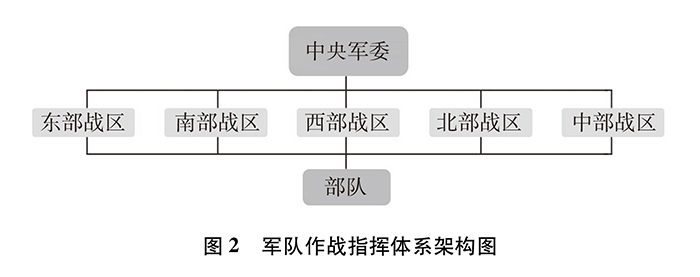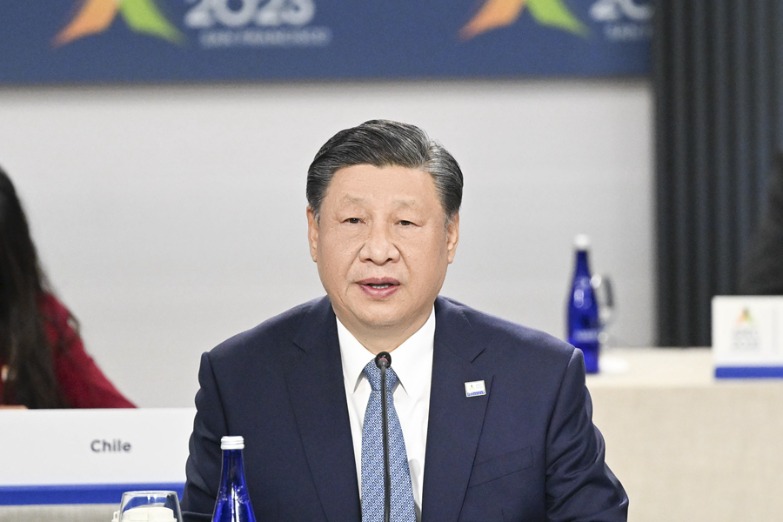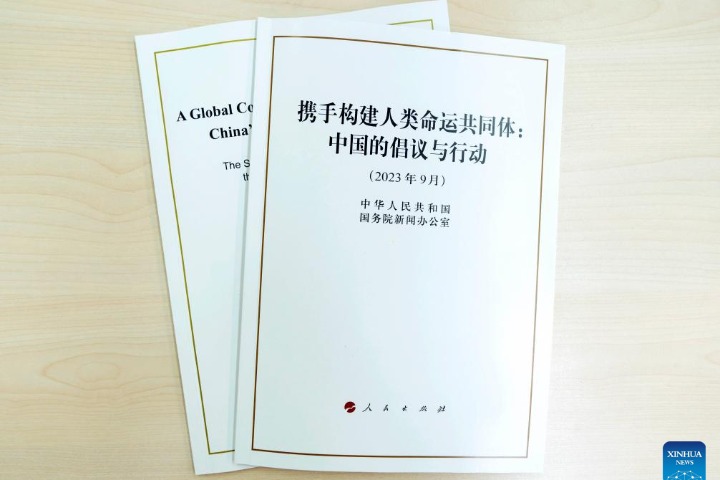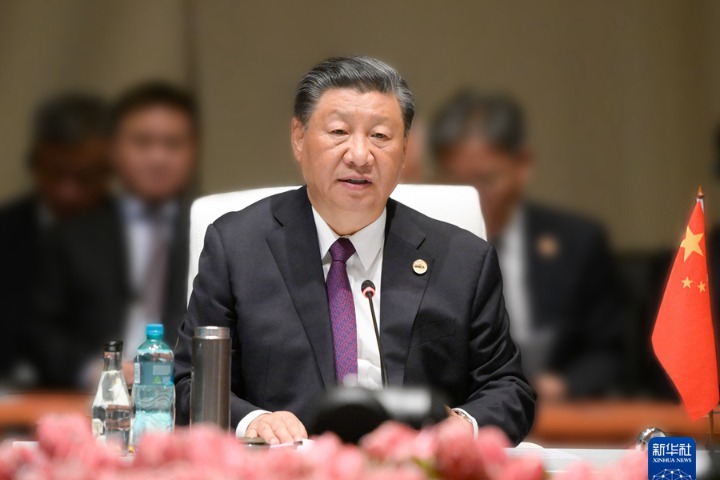新时代的中国国防(双语全文)
新华网 2019-07-24 13:54

四、改革中的中国国防和军队
IV. Reform in China’s National Defense and Armed Forces
人民军队发展史,就是一部改革创新史。进入新时代,适应世界新军事革命发展趋势和国家安全需求,中国全面推进国防和军队现代化建设,全面深化国防和军队改革,着力解决体制性障碍、结构性矛盾、政策性问题,迈出了强军兴军历史性步伐。
The history of the people’s armed forces is a history of reform and innovation. In the new era, China is advancing defense and military modernization across the board and deepening reform in national defense and armed forces in all respects, with a focus on removing institutional barriers and solving structural and policy-related problems to adapt to the trends of worldwide RMA and the demands of national security. Historic strides have been made in strengthening the armed forces.
重塑领导指挥体制
Reforming the Leadership and Command System
领导指挥体制改革是适应现代军队专业化分工和信息时代能打仗、打胜仗的要求,提高军队作战效能和建设效益的重大举措。按照“军委管总、战区主战、军种主建”原则,强化军委集中统一领导和战略指挥、战略管理功能,打破长期实行的总部体制、大军区体制、大陆军体制,构建新的军队领导管理和作战指挥体制。
The reform in the leadership and command system is a significant measure in response to the call of a modern and specialized military capable of fighting and winning wars in the information age, aiming to improve the operational effectiveness and development efficiency of the military. Adhering to the general principle of “the CMC exercising overall leadership, the TCs responsible for military operations and the services focusing on developing capabilities”, the PLA endeavors to enhance the CMC’s centralized and unified leadership and its functions of strategic command and strategic management. The PLA has dismantled the long-established systems of general departments, military area commands (MAC) and the force composition with a dominating land force, and established new leadership, management and operational command systems.
调整组建新的军委机关部门。优化军委机关职能配置和机构设置,由过去的总参谋部、总政治部、总后勤部、总装备部四总部调整为军委机关15个职能部门,作为军委集中领导的参谋机关、执行机关、服务机关。指挥、建设、管理、监督等路径更加清晰,决策、规划、执行、评估等职能配置更加合理。
Reorganizing and establishing new CMC functional organs. To optimize the functional and institutional setup of the CMC organs, the former General Staff Headquarters, General Political Department, General Logistics Department and General Armaments Department have been reshuffled into 15 organs under the centralized CMC leadership to advise, execute and serve. Thus, the chains of command, development, management and supervision are more streamlined, and the responsibilities of decision-making, planning, execution and assessment are more properly delegated.
完善军兵种领导管理体制。整合原四总部的陆军建设职能,成立陆军领导机构;整合各军种和军委机关的战略支援力量,成立战略支援部队;第二炮兵更名为火箭军;整合主要承担通用保障任务的战略战役力量,成立联勤保障部队,构建起“中央军委-军种-部队”的领导管理体系。
Improving the leadership and management system for services and arms. The PLA has:
•Established the PLAA leading organs by integrating the functions of the former general departments concerning the development of the land force;
•Established the PLASSF by combining strategic support forces across the services and CMC organs;
•Renamed the Second Artillery Force the PLARF; and
•Established the PLAJLSF by integrating strategic and campaign level forces mainly for general-purpose support.
Thus, a CMC-Services-Troops leadership and management system has been put in place.

建立健全联合作战指挥体制。健全军委联合作战指挥机构,组建战区联合作战指挥机构,形成平战一体、常态运行、专司主营、精干高效的联合作战指挥体系。撤销沈阳、北京、兰州、济南、南京、广州、成都7个大军区,成立东部、南部、西部、北部、中部5个战区。通过改革,构建起“中央军委-战区-部队”的作战指挥体系。
Establishing and improving the joint operations command system. By improving the joint operations command organ of the CMC and setting up those at the theater level, the PLA has established a lean and efficient joint operations command system composed of permanent and specialized commanding establishments for both peacetime and wartime operations. The former Shenyang, Beijing, Lanzhou, Jinan, Nanjing, Guangzhou and Chengdu MACs have been reorganized into 5 TCs: Eastern Theater Command (ETC), Southern Theater Command (STC), Western Theater Command (WTC), Northern Theater Command (NTC), and Central Theater Command (CTC). Thus, a CMC-TCs-Troops operations command system has been established.

建立健全法治监督体系。组建新的军委纪律检查委员会(军委监察委员会),由中央军委直接领导,向军委机关部门和各战区派驻纪检组;组建新的军委政法委员会,按区域设置军事法院、军事检察院;组建军委审计署,改革审计监督体制,全部实行派驻审计,形成决策权、执行权、监督权既相互制约又相互协调的权力运行体系。
Building and improving the law-based supervision system. The Chinese military has established the CMC Discipline Inspection Commission (CMCDIC, also the CMC Supervision Commission, CMCSC) under the direct leadership of the CMC, and dispatched disciplinary inspection teams to the CMC functional organs and all TCs. It has set up the CMC Politics and Law Commission (CMCPLC) and established regional military courts and procuratorates. It has put into place the CMC Audit Office (CMCAO), reformed the audit-based oversight system, and implemented PLA-wide resident auditing. Thus, power is exercised in a way that decision-making, execution and supervision check each other and function in coordination.
优化规模结构和力量编成
Optimizing Size, Structure and Force Composition
规模结构和力量编成改革是推进军队组织形态现代化、构建中国特色现代军事力量体系的关键一步。按照调整优化结构、发展新型力量、理顺重大比例关系、压减数量规模的要求,推动军队由数量规模型向质量效能型、人力密集型向科技密集型转变。
Reform in size, structure and force composition is a pivotal step to optimizing military organizational structure and establishing a modern military force structure with Chinese characteristics. Following the instruction to optimize structures, develop new-type forces, adjust proportions and reduce sizes, the PLA is striving to transform from a quantity-and-scale model to that of quality and efficiency, as well as from being personnel-intensive to one that is S&T-intensive.
调整军队规模比例,重塑力量结构布局。裁减军队员额30万,现役总员额减至200万。扩大士官和文职人员编配范围,压减各级机关编制,减少各级机关内设机构、领导层级和人员,精简文艺体育新闻出版、服务保障和院校、医疗、仓库、科研院所等机构和人员,团级以上机关人员减少约四分之一,非战斗单位人员压减近一半。大幅压减陆军现役员额,保持空军现役员额稳定,适度增加海军、火箭军现役员额,优化各军兵种内部力量结构。优化后备力量结构。调整作战力量部署,形成与维护新时代国家安全需要相适应的战略布局。
Adjusting scale and proportion, and restructuring force composition. 300,000 personnel have been cut to keep the total active force at 2 million. Reform measures have been taken to transfer more officer positions to non-commissioned officers and civilian staff, downsize the leading organs at all levels by reducing their subordinate sections, leadership hierarchies and staff, and streamline the institutions and personnel in arts, sports, press, publication, logistical support, medical facilities, depots, and educational and research institutes. Thus, the number of personnel in the leading organs at and above regiment level has been cut by about 25%, and that of non-combat units by almost 50%. The PLA has significantly downsized the active force of the PLAA, maintained that of the PLAAF at a steady number, moderately increased that of the PLAN and PLARF, and optimized the force structures of all services and arms. The PLA has restructured the defense reserves. The deployment of combat forces has been adjusted for a strategic configuration that meets the demands of safeguarding China’s national security in the new era.
调整作战部队编成,重构新型作战力量。陆军原18个集团军整合重组为13个集团军。在全军主要作战部队实行“军-旅-营”体制,充实兵种作战力量,减少指挥层级,降低合成重心。增加特种作战、立体攻防、两栖作战、远海防卫、战略投送等新型作战力量,推动部队编成向充实、合成、多能、灵活方向发展。
Reorganizing the troops and rebuilding new-type combat forces. The previous 18 group armies have been reorganized into 13 new ones. All major combat units of the PLA follow a group army-brigade-battalion system. Reform measures have been taken to reinforce the combat capacity of the arms, reduce the command hierarchies and combine the troops at lower levels. New types of combat forces have been enhanced to conduct special operations, all-dimensional offense and defense, amphibious operations, far seas protection and strategic projection, aiming to make the force composition complete, combined, multi-functional and flexible.
优化院校力量布局,重构军事科研体系。解放军和武警部队原有77所院校整合为44所,重塑国防大学、国防科技大学。成立军委军事科学研究指导委员会,调整组建新的军事科学院、军种研究院,形成以军事科学院为龙头、军兵种科研机构为骨干、院校和部队科研力量为辅助的军事科研力量布局。
Rebalancing and reorganizing military educational and research institutions. The PLA and the PAP have restructured the previous 77 universities and colleges into 44. The National Defense University (NDU) and the National University of Defense Technology (NUDT) have been reorganized. China’s armed forces have established the CMC Steering Committee on Military Scientific Research and reorganized the Academy of Military Sciences (AMS) and the research institutes of the services. Thus, the military scientific research forces have been rebalanced with the AMS as the lead, the research institutes of the services and arms as the main forces, and the research components in educational institutions and the troops as supplements.
推进军事政策制度改革
Reforming Military Policies and Institutions
坚持战斗力标准,着眼调动军事人员积极性、主动性、创造性,整体设计和推进军事政策制度改革,建立健全中国特色社会主义军事政策制度体系。
China’s armed forces take combat effectiveness as the criterion in the reform of military policies and institutions and encourage the initiative, enthusiasm and creativity of all members of the armed forces. Reform is designed to build and improve the system of socialist military policies and institutions with Chinese characteristics.
深化军队党的建设制度改革,维护党中央权威和集中统一领导,确保党对军队绝对领导。制定《关于加强新时代军队党的建设的决定》等法规制度,推进完善军队党的政治建设、思想建设、组织建设、作风建设、纪律建设制度。
They have deepened reform in the institutions for Party building in the military to uphold the authority of the CPCCC and its centralized and unified leadership, and ensure the absolute leadership of the CPC over the military. Rules and regulations including the Decision of China’s Armed Forces on Strengthening Party Building in the Military in the New Era have been formulated to improve the Party’s institutions in the military in order to enhance its political and theoretical buildup, consolidate organizations, improve conduct, and enforce discipline.
创新军事力量运用政策制度,有效保障全面履行新时代军队使命任务。制定《海上护航行动条例(试行)》等法规制度,推进完善军事战略指导制度、战备工作条例、联合作战法规等。
They have innovated in policies and institutions for military force employment in a bid to effectively perform all missions and tasks in the new era. Rules and regulations have been formulated including the Regulations on Vessel Protection Operations (Trial). The institutions of military strategic guidance, regulations on combat readiness duties, and rules and regulations on joint operations have all been optimized.
重塑军事力量建设政策制度,更好解放和发展战斗力。制定修订《国防交通法》《军事设施保护法》《文职人员条例》等法规制度,颁布实施新军事训练条例和军事训练大纲。推进建立军官职业化制度,优化军人待遇保障,健全军人荣誉体系,完善军事训练、装备发展、后勤建设、军事科研、国防动员等方面政策制度,加快推进军官法、兵役法等立法进程。
They have reformulated policies and institutions to further develop combat capabilities. Laws and regulations have been formulated and amended including the Law of the People’s Republic of China on National Defense Transportation, the Law of the People’s Republic of China on the Protection of Military Installations and the Regulations on Civilian Personnel in the Military. Newly-updated military training regulations and outlines have been promulgated. They have made progress in establishing the career officers system, optimizing the institutions of military welfare and support, improving the military honors system, and refining policies and institutions in training, equipment development, logistics, military research and national defense mobilization. Meanwhile, bigger legislative steps have been taken in relation to military officers and military service.
改革军事管理政策制度,提升军事系统运行效能,推动军队高质量发展。制定修订《内务条令(试行)》《纪律条令(试行)》《队列条令(试行)》《军事立法工作条例》等法规制度,推进战略管理、军费管理、军事司法等制度创新。
They have reformed the policies and institutions for military management to elevate the efficacy of military systems and boost quality development of the military. Rules and regulations have been formulated including the newly-updated Regulations on Routine Service of the People’s Liberation Army (Trial), the Regulations on Discipline of the People’s Liberation Army (Trial), the Regulations on Formation of the People’s Liberation Army (Trial), and the Regulations on Military Legislation. China’s armed forces are enhancing institutional innovation in strategic management, defense expenditure management, and the military judicial system.
全面停止军队有偿服务。截至2018年6月,军队各级机关、部队及其所属事业单位从事的房地产租赁、农副业生产、招接待等15个行业的有偿服务活动基本停止,超过10万个有偿服务项目按期停止,累计停偿项目比例达到94%,军队不从事经营活动的目标基本实现。
They have suspended all paid services. As of June, 2018, paid services provided by leading organs, operational units, and military-affiliated public institutions at all levels had been basically suspended, involving 15 sectors such as real estate lease, agricultural and associated products, and hospitality. Over 100,000 such projects have been suspended as scheduled, accounting for 94% of the total. The armed forces have achieved the goal of withdrawing from running businesses.
调整改革后的军兵种和武警部队
Reshuffled PLA and PAP Troops
陆军对维护国家主权、安全、发展利益具有不可替代的作用。包括机动作战部队、边海防部队、警卫警备部队等,下辖5个战区陆军、新疆军区、西藏军区等。东部战区陆军下辖第71、72、73集团军,南部战区陆军下辖第74、75集团军,西部战区陆军下辖第76、77集团军,北部战区陆军下辖第78、79、80集团军,中部战区陆军下辖第81、82、83集团军。按照机动作战、立体攻防的战略要求,加快实现区域防卫型向全域作战型转变,提高精确作战、立体作战、全域作战、多能作战、持续作战能力,努力建设一支强大的现代化新型陆军。
The PLAA plays an irreplaceable role in maintaining China’s national sovereignty, security and development interests. It comprises maneuver operation, border and coastal defense, and garrison forces. Under the PLAA, there are 5 TC army commands, the Xinjiang military command, and the Tibet military command. The ETC Army has under it the 71st, 72nd, and 73rd group armies; the STC Army has the 74th and 75th group armies; the WTC Army has the 76th and 77th group armies; the NTC Army has the 78th, 79th and 80th group armies; and the CTC Army has the 81st, 82nd and 83rd group armies. In line with the strategic requirements of maneuver operations as well as multi-dimensional offense and defense, the PLAA is speeding up the transition of its tasks from regional defense to trans-theater operations, and improving the capabilities for precise, multi-dimensional, trans-theater, multi-functional and sustained operations, so as to build a new type of strong and modernized land force.
海军在国家安全和发展全局中具有十分重要的地位。包括潜艇部队、水面舰艇部队、航空兵、陆战队、岸防部队等,下辖东部战区海军(东海舰队)、南部战区海军(南海舰队)、北部战区海军(北海舰队),海军陆战队等。战区海军下辖基地、潜艇支队、水面舰艇支队、航空兵旅等部队。按照近海防御、远海防卫的战略要求,加快推进近海防御型向远海防卫型转变,提高战略威慑与反击、海上机动作战、海上联合作战、综合防御作战和综合保障能力,努力建设一支强大的现代化海军。
The PLAN has a very important standing in the overall configuration of China’s national security and development. It comprises submarine, surface ship, aviation, marine, and coastal defense forces. Under the PLAN, there are the ETC Navy (Donghai Fleet), the STC Navy (Nanhai Fleet), the NTC Navy (Beihai Fleet), and the PLAN Marine Corps. Under the TC navies there are naval bases, submarine flotillas, surface ship flotillas and aviation brigades. In line with the strategic requirements of near seas defense and far seas protection, the PLAN is speeding up the transition of its tasks from defense on the near seas to protection missions on the far seas, and improving its capabilities for strategic deterrence and counterattack, maritime maneuver operations, maritime joint operations, comprehensive defense, and integrated support, so as to build a strong and modernized naval force.
空军在国家安全和军事战略全局中具有举足轻重的地位和作用。包括航空兵、空降兵、地面防空兵、雷达兵、电子对抗部队、信息通信部队等,下辖5个战区空军、1个空降兵军等。战区空军下辖基地、航空兵旅(师)、地空导弹兵旅(师)、雷达兵旅等部队。按照空天一体、攻防兼备的战略要求,加快实现国土防空型向攻防兼备型转变,提高战略预警、空中打击、防空反导、信息对抗、空降作战、战略投送和综合保障能力,努力建设一支强大的现代化空军。
The PLAAF plays a crucial role in overall national security and military strategy. It comprises aviation, airborne, ground-to-air missile, radar, ECM, and communications forces. Under the PLAAF, there are 5 TC air force commands and one airborne corps. Under the TC air forces, there are air bases, aviation brigades (divisions), ground-to-air missile brigades (divisions) and radar brigades. In line with the strategic requirements of integrating air and space capabilities as well as coordinating offensive and defensive operations, the PLAAF is accelerating the transition of its tasks from territorial air defense to both offensive and defensive operations, and improving its capabilities for strategic early warning, air strikes, air and missile defense, information countermeasures, airborne operations, strategic projection, and integrated support, so as to build a strong and modernized air force.
火箭军在维护国家主权、安全中具有至关重要的地位和作用。包括核导弹部队、常规导弹部队、保障部队等,下辖导弹基地等。按照核常兼备、全域慑战的战略要求,增强可信可靠的核威慑和核反击能力,加强中远程精确打击力量建设,增强战略制衡能力,努力建设一支强大的现代化火箭军。
The PLARF plays a critical role in maintaining China’s national sovereignty and security. It comprises nuclear missile, conventional missile and support forces, and subordinate missile bases. In line with the strategic requirements of having both nuclear and conventional capabilities and deterring wars in all battlespaces, the PLARF is enhancing its credible and reliable capabilities of nuclear deterrence and counterattack, strengthening intermediate and long-range precision strike forces, and enhancing strategic counter-balance capability, so as to build a strong and modernized rocket force.
战略支援部队是维护国家安全的新型作战力量,是新质作战能力的重要增长点。包括战场环境保障、信息通信保障、信息安全防护、新技术试验等保障力量。按照体系融合、军民融合的战略要求,推进关键领域跨越发展,推进新型作战力量加速发展、一体发展,努力建设一支强大的现代化战略支援部队。
The PLASSF is a new type of combat force for safeguarding national security and an important driver for the growth of new combat capabilities. It comprises supporting forces for battlefield environment, information, communications, information security, and new technology testing. In line with the strategic requirements of integrating existing systems and aligning civil and military endeavors, the PLASSF is seeking to achieve big development strides in key areas and accelerate the integrated development of new-type combat forces, so as to build a strong and modernized strategic support force.
联勤保障部队是实施联勤保障和战略战役支援保障的主体力量,是中国特色现代军事力量体系的重要组成部分。包括仓储、卫勤、运输投送、输油管线、工程建设管理、储备资产管理、采购等力量,下辖无锡、桂林、西宁、沈阳、郑州5个联勤保障中心,以及解放军总医院、解放军疾病预防控制中心等。按照联合作战、联合训练、联合保障的要求,加快融入联合作战体系,提高一体化联合保障能力,努力建设一支强大的现代化联勤保障部队。
The PLAJLSF, as the main force for joint logistics as well as strategic and campaign level support, is an important component of the modern military force with Chinese characteristics. It comprises the support forces for inventory and warehousing, medical services, transport, force projection, oil pipelines, engineering and construction management, reserve assets management, and procurement. Under the PLAJLSF, there are 5 joint logistic support centers located respectively in Wuxi (Jiangsu Province), Guilin (Guangxi Zhuang Autonomous Region), Xining (Qinghai Province), Shenyang (Liaoning Province), and Zhengzhou (Henan Province), as well as the PLA General Hospital and the PLA Center for Disease Prevention and Control. In line with the requirements of joint support for joint operations and joint training, the PLAJLSF is being integrated into the joint operations system to enhance the capabilities of integrated joint logistics, so as to build a strong and modernized joint logistic support force.
武警部队在维护国家安全和社会稳定、保卫人民美好生活中肩负着重大职责,实行“中央军委-武警部队-部队”领导指挥体制,武警部队的根本职能属性没有发生变化,不列入解放军序列。公安边防部队、公安消防部队、公安警卫部队退出现役,国家海洋局领导管理的海警队伍转隶武警部队,武警黄金、森林、水电部队整体移交国家相关职能部门并改编为非现役专业队伍,撤收武警部队海关执勤兵力,彻底理顺武警部队领导管理和指挥使用关系。调整后,武警部队包括内卫部队、机动部队、海警部队等。按照多能一体、有效维稳的战略要求,加强执勤、处突、反恐、海上维权和行政执法、抢险救援等能力建设,努力建设一支强大的现代化武警部队。
The PAP shoulders important responsibilities in safeguarding national security, social stability and public wellbeing. China has adopted a CMC-PAP-Troops leadership and command system with the basic duties and nature of the PAP unchanged. The PAP is not in the force structure of the PLA. The PAP border defense, firefighting and security guard forces have been decommissioned. The coast guard under the leadership of State Oceanic Administration has been transferred to the PAP. PAP goldmine, forest and hydroelectricity forces have been reorganized into specialized forces of non-active service under corresponding state authorities. Meanwhile, the PAP customs guard forces have been withdrawn. In this way, the leadership, management, command and employment of the PAP has become more coherent. Following adjustment and reorganization, the PAP is mainly composed of the internal security corps, the mobile corps, and the coast guard. In line with the strategic requirements of performing multiple functions and effectively maintaining social stability, the PAP is enhancing capacity in guard duties, emergency response, counter-terrorism, maritime rights protection, administrative enforcement and disaster relief, so as to build a strong and modernized armed police force.
推进国防和军队全面建设
Promoting Defense and Military Development in All Respects
始终把思想政治建设摆在军队各项建设首位。牢固确立习近平强军思想的指导地位,坚决维护习近平总书记党中央的核心、全党的核心地位,坚决维护党中央权威和集中统一领导,贯彻中央军委主席负责制,政治意识、大局意识、核心意识、看齐意识进一步增强。2014年12月印发《关于新形势下军队政治工作若干问题的决定》,推进政治整训,军队重整行装再出发。2018年8月召开中央军委党的建设会议,全面加强新时代军队党的领导和党的建设工作。着力培养有灵魂、有本事、有血性、有品德的新时代革命军人,锻造具有铁一般信仰、铁一般信念、铁一般纪律、铁一般担当的过硬部队。
Placing theoretical and political buildup at the top of the agenda of the armed forces. China’s armed forces unswervingly take Xi Jinping’s thinking on strengthening the military as the guidance, firmly uphold General Secretary Xi Jinping as the core of the CPCCC and the whole Party, firmly uphold the authority of the CPCCC and its centralized and unified leadership, and follow the CMC Chairman responsibility system, in an effort to further strengthen the consciousness of the need to maintain political integrity, think in big-picture terms, follow the leadership core and keep in alignment. In accordance with the Decision on Issues Relating to the Military Political Work in the New Era issued in December 2014, China’s armed forces have improved their political work and embarked on a new journey of development. In order to fully strengthen the Party leadership and Party building of the military in the new era, a CMC meeting on party building was held in August, 2018. Great efforts are being made to cultivate revolutionary officers and soldiers of the new era with faith, ability, courage and integrity, and build troops with iron-like faith, conviction, discipline and commitment.
推进国防科技和军事理论创新发展。加快实施科技兴军战略,巩固和加强优势领域,加大新兴领域创新力度,一些战略性、前沿性、颠覆性技术自主创新取得重要进展,成功研制天河二号超级计算机等一批高技术成果。聚焦战争和作战问题推进军事理论创新,推出战略、联合作战、信息化建设等一系列理论成果,为国防和军队建设提供理论支撑。
Promoting innovation in defense S&T and military theory. China’s armed forces are accelerating the implementation of the strategy to develop the military through S&T in a bid to maintain and enhance the strength of the areas where they lead, and intensify innovation in emerging areas. They have made great progress in independent innovation in some strategic, cutting-edge and disruptive technologies, and succeeded in developing strategic hi-tech products such as the Tianhe-2 supercomputer. Focusing on war and fighting wars, China’s armed forces have innovated in military doctrines and delivered outcomes in military strategy, joint operations and informationization, which have provided a theoretical support to defense and military development.
构建现代化武器装备体系。完善优化武器装备体系结构,统筹推进各军兵种武器装备发展,统筹主战装备、信息系统、保障装备发展,全面提升标准化、系列化、通用化水平。加大淘汰老旧装备力度,逐步形成以高新技术装备为骨干的武器装备体系。15式坦克、052D驱逐舰、歼-20战斗机、东风-26中远程弹道导弹等装备列装部队。
Establishing a modernized weaponry and equipment system. China’s armed forces are optimizing the overall composition of weaponry and equipment, coordinating the efforts of all services and arms in this regard, promoting the balanced development of main battle equipment, information systems, and support equipment, with a view to comprehensively raising standardization, serial development and interoperability. Old equipment is being phased out, and a system created that mainly comprises new and high-tech weaponry and equipment. Type 15 tanks, type 052D destroyers, J-20 fighters, and DF-26 intermediate and long-range ballistic missiles have been commissioned.
建设一切为了打仗的现代化后勤。建立以联勤部队为主干、军种为补充,统分结合、通专两线的保障体制,构建以战略战役力量为主干、队属力量为补充、社会保障为依托,联合、精干、高效的后勤力量体系,推动后勤力量融入战区联合训练、军兵种跨区训练和中外联演联训,推进前后方一体训练,初步形成快速响应、全维参战、精确保障能力。
Building a combat-oriented modern logistics system. China’s armed forces are putting in place a support mechanism combining centralized and decentralized support, as well as general and special-purpose supplies, with PLAJLSF as the backbone force and service logistics units as supplements. They are also building a joint, lean and efficient logistic support system with the strategic and campaign level forces as the main force, the affiliated forces as the support, and the civil sectors as supplements. Logistics units have been incorporated into TC-level joint training, trans-theater training by services and arms, and joint exercises and training with foreign militaries to strengthen the integrated training of logistical and operational forces. China’s armed forces have acquired a rapid, multi-dimensional and precise support capability.
强化战略管理。坚持需求牵引规划、规划主导资源配置,建立完善“需求-规划-预算-执行-评估”的战略管理链路。制定军队发展战略和重要领域、军兵种、武警部队发展战略,形成战略规划和计划体系。规范军队战略规划工作,颁布实施《军队建设发展“十三五”规划纲要》,健全评估、督导、调控等制度机制。
Strengthening strategic management. Adopting demand-oriented planning and planning-led resource allocation, China’s armed forces have established and improved the strategic management procedures of demand-planning-budgeting-execution-evaluation. They have completed a system of strategic plans and programs composed of the development strategies of the military as a whole, and its key areas, branches, and the PAP. They have regulated military strategic planning, promulgated and implemented the Outline of the 13th Five-Year Plan for Military Development, and optimized the mechanisms for evaluation, supervision and control.
坚持依法治军从严治军。构建完善中国特色军事法治体系,推动治军方式根本性转变。强化练兵备战监督监察,深入纠治和平积弊。广泛开展法治宣传教育,建立健全法律咨询服务保障机制,推进法治军营建设。全面从严加强部队管理,贯彻落实条令条例,恢复和完善军队司号制度,组织全军安全大检查,加强重大安全隐患排查整治,加大警备纠察工作力度,开展军车管理专项整顿,建立警备工作定期通报机制,维护军队良好形象。
Governing the military with strict discipline and in accordance with the law. China’s armed forces are building a military legal system with Chinese characteristics and pressing ahead with a fundamental transformation in how the military is run. They are strengthening oversight and supervision in military training and combat readiness to uproot peacetime ills. They are promoting legal awareness through public communication and education campaigns, establishing and improving the support mechanism of legal consultation and service, and advancing law-based management in the military. China’s armed forces are striving to manage the troops more strictly in all respects. They have fully implemented military rules and regulations, restored and improved the traditional mechanism of using bugles to communicate and command, carried out safety inspections to identify and tackle potential problems, stepped up garrison military policing, strengthened the management of military vehicles by targeted measures, and set up a mechanism of regular notification on garrison military policing. These efforts have contributed to maintaining the positive image of the armed forces.
深入推进党风廉政建设和反腐败斗争。严明政治纪律政治规矩,严肃查处郭伯雄、徐才厚、房峰辉、张阳等严重违纪违法案件。严格依纪依法惩治腐败,开展重大工程建设、装备物资采购等行业领域专项整治。建立基层风气监察联系点制度,查纠官兵身边“微腐败”和不正之风。深化政治巡视,完成对军委机关部门、大单位巡视和回访巡视全覆盖。着力推进审计全覆盖,加大重点领域、重大项目、重要资金审计力度,严格领导干部经济责任审计,积极推行经费绩效审计、全程跟踪审计、军地联合审计。2012年以来,共审计3.9万个(次)单位(部门)、1.3万名团以上领导干部。反腐败斗争取得压倒性胜利,风清气正的良好政治生态基本形成。
Improving Party conduct, upholding integrity and continuing the fight against corruption. China’s armed forces are tightening political discipline and rules, investigating and dealing strictly with grave violations of CPC discipline and state laws as in the cases of Guo Boxiong, Xu Caihou, Fang Fenghui, and Zhang Yang. China’s armed forces punish corruption in strict accordance with CPC discipline and relevant laws, and rectify any malpractice in key construction projects and the procurement of equipment and material. Points-of-contact for discipline supervision have been designated at the small-unit level to investigate and combat “micro corruption” and misconduct in all its forms among service members. China’s armed forces have intensified political inspection by completing disciplinary inspections and re-inspections over all CMC functional organs, the TCs, services, AMS, NDU, NUDT and the PAP. They have worked to implement full-spectrum audit, intensify the audit of major fields, projects and funds, and perform strict audits over the economic liabilities of officers in positions of leadership. Active efforts have been made to monitor the cost-effectiveness of applied funds, conduct whole-process audit, and combine civil and military efforts in auditing. Since 2012, they have carried out audits over 39,000 units and 13,000 PLA and PAP officers in positions of leadership at and above regiment level. As a result, notable achievements have been made in the fight against corruption in China’s armed forces, and a healthy political atmosphere of integrity has formed.
推进国防动员现代化建设。理顺国防动员组织领导体制,加强后备力量建设,精简全国基干民兵规模,深化民兵预备役部队规模结构、力量编成改革,推进预备役部队与现役部队一体建设和运用,加快实现由保障陆军为主向保障多军兵种转变。
Modernizing national defense mobilization. China has refined the system of national defense mobilization to enhance the development of its defense reserves. China is streamlining the number of primary militia nationwide, driving deeper reform of militia and reserve forces in their size, structure and composition, promoting integrated development and employment of the reserve and active forces, and extending the function of national defense mobilization from mainly supporting the land force to supporting all branches at a faster pace.
结合深化党和国家机构改革,组建退役军人事务部,推进省、市、县、乡镇(街道)、村(社区)退役军人服务保障体系建设,出台一系列优待优抚措施。扎实做好拥军优属、拥政爱民工作,积极参与脱贫攻坚,军政军民团结不断巩固,尊重军人、优待军人的社会氛围正在形成。
In the process of deepening the reform of the CPC and governmental institutions, the Ministry of Veterans Affairs of the PRC has been set up. Through a series of preferential measures, the veteran support system is progressing at provincial, prefectural, county, town and township (sub-district), and village (community) levels. Substantial steps have been taken to enhance the government’s efforts to support the military and their families, and to strengthen the military’s support to the government and the people. China’s armed forces play an active role in poverty alleviation. The relationships between the military and the government and between the military and the people are getting even closer. There is a growing consensus across communities to respect and give preferential treatment to all service members.

















 英语点津微信
英语点津微信 双语小程序
双语小程序